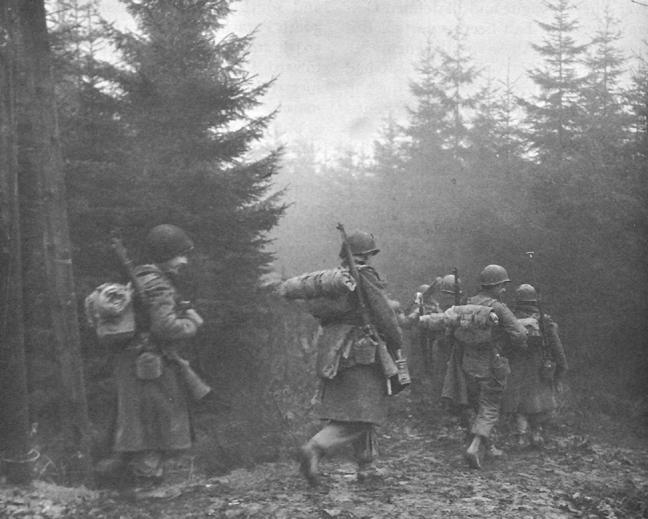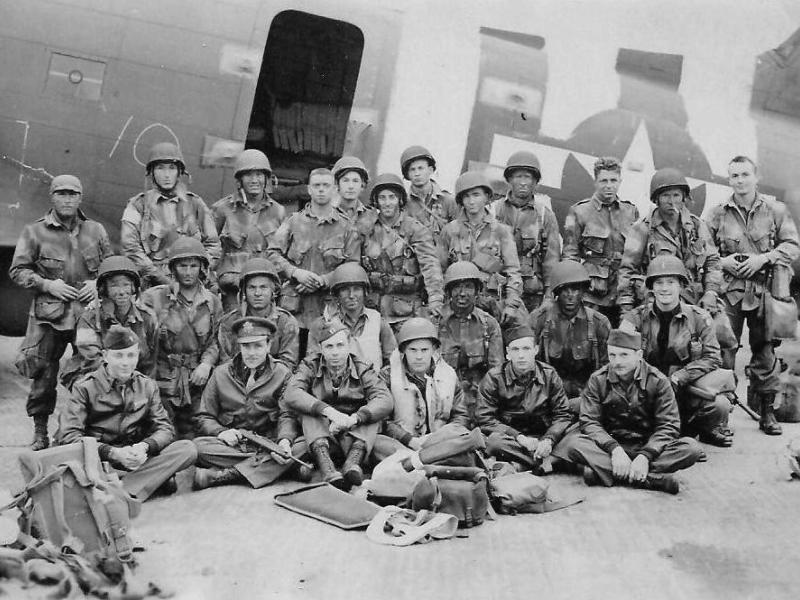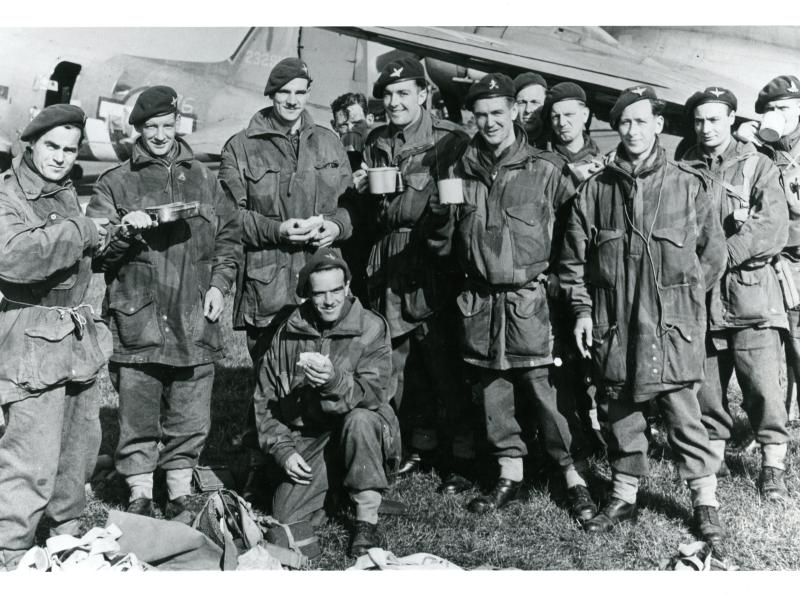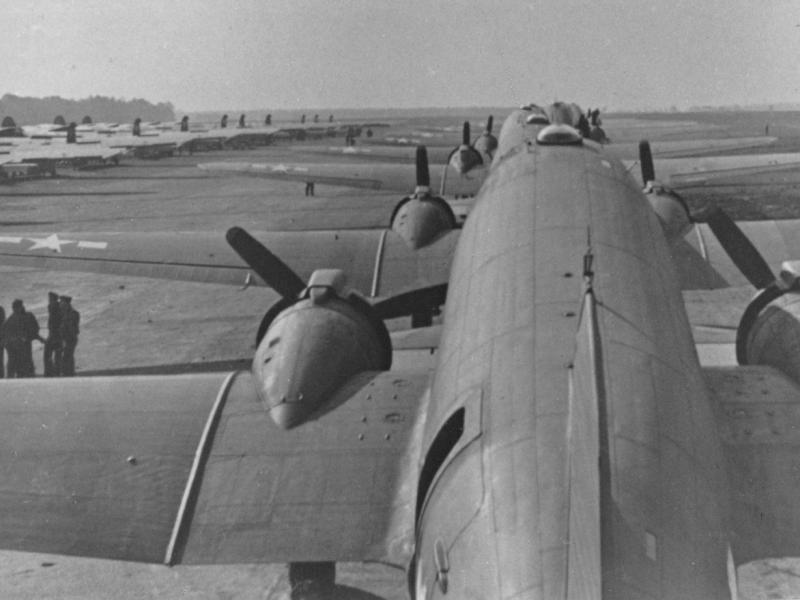US Airborne Forces in the East Midlands, 1943-45
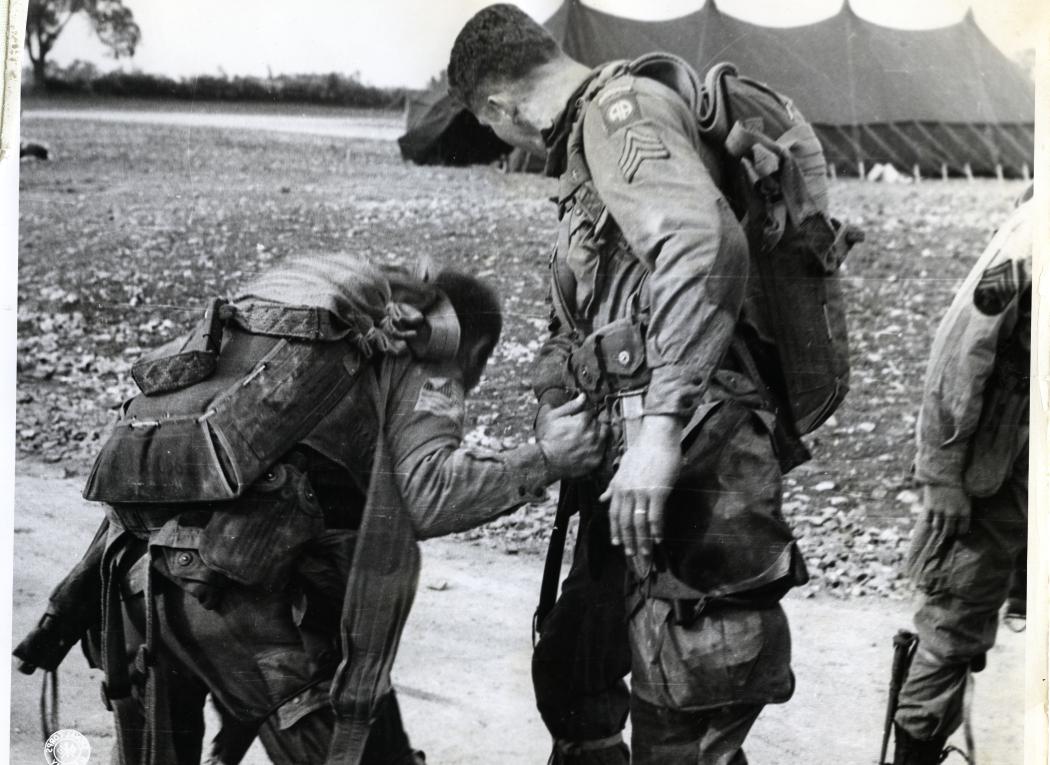
AIR COMPONENT
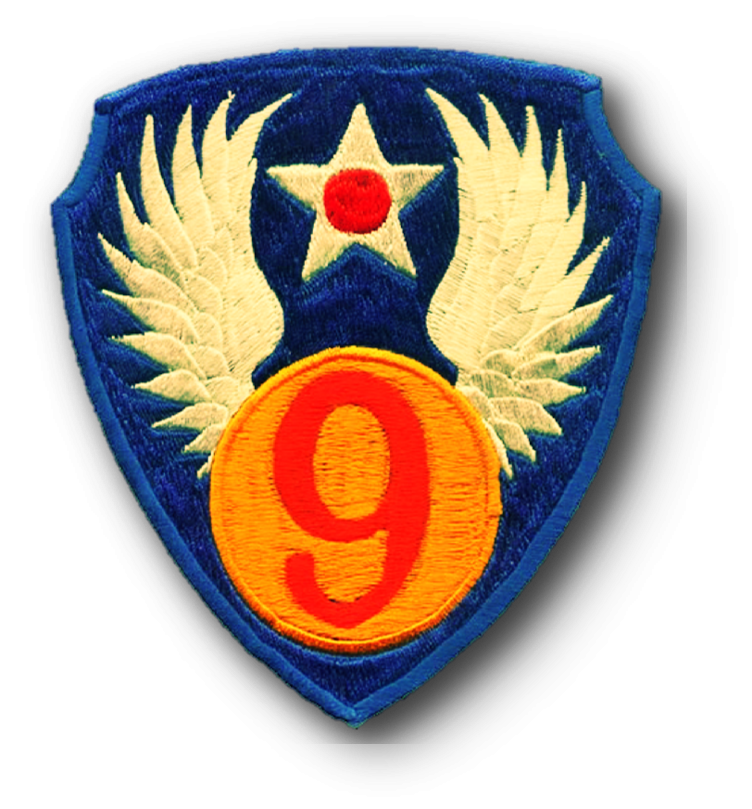
US Ninth Air Force
The US Ninth Air Force was a tactical organization, meaning that its role was to provide offensive and defensive support for ground forces. This support included the delivery of paratroopers and gliders into combat areas.
The Ninth Air Force had been formed in the United States in April 1942 and had begun operations in the Mediterranean theatre in November 1942. It subsequently fought in Egypt, Libya, Tunisia, Sicily and Italy before re-forming in Britain in October 1943.
While the Headquarters of the Ninth Air Force was at Ascot in southern England, the Headquarters of one of its key components was at Grantham from December 1943 to September 1944: IX Troop Carrier Command (the US Army Air Force used Roman numerals in some organizational names during World War II; in this case, 'IX' is the Roman numeral for '9').
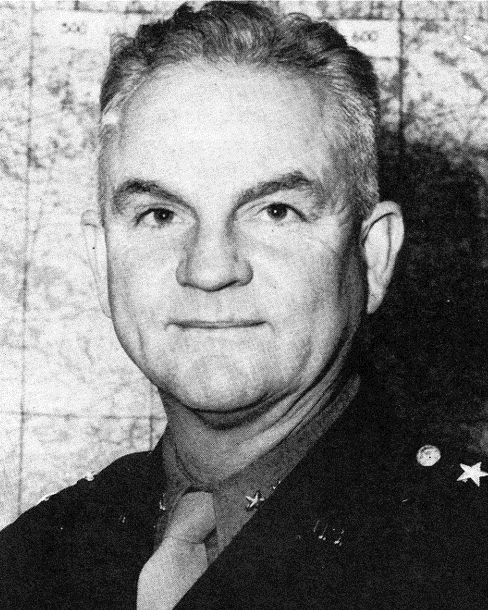
Major General Paul Williams, Commander, US Ninth Troop Carrier Command. (Official Photo, USAAF - Wings at War No. 4: Airborne Assault on Holland, p. 19; public domain)
IX Troop Carrier Command: Unsung Heroes in an Unglamorous Role
IX Troop Carrier Command (IX TCC) was activated in England on 16 October 1943. In February 1944, Brigadier General (later Major General) Paul L Williams assumed command, and he was quartered in Marston Hall, in the village of Marston, just north of Grantham. Its units were based at airfields in the East Midlands and southern England.
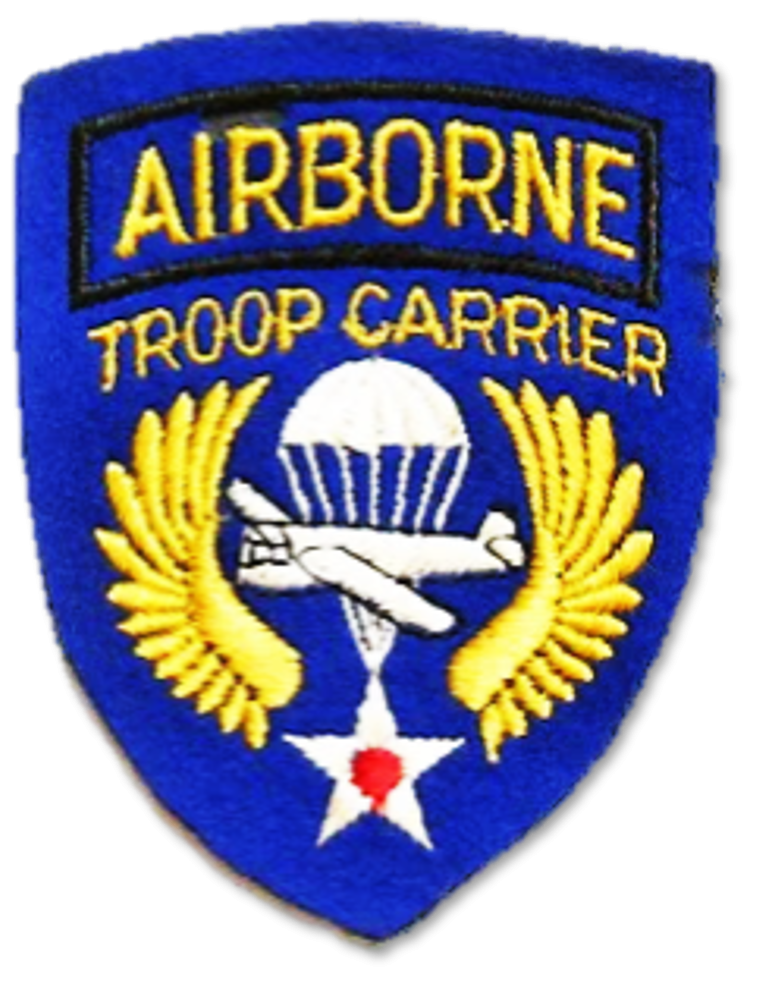
Sleeve insignia worn by members of IX Troop Carrier Command before August 1944.
The role of IX TCC was to provide aircraft and gliders to convey troops and cargo into combat within the European Theatre of Operations, which included British and Polish troops whose own nations had insufficient or no airlift capability of their own.
IX TCC comprised three Troop Carrier Wings (TCWs) - 50th, 52nd and 53rd TCWs - each of which was made up of several Troop Carrier Groups (TCGs). As TCGs were classed as combat units, they were used to transport supplies close to the frontlines - delivering essential items such as fuel, whole and dried blood supplies, rations and ammunition - and to evacuate injured personnel from airfields and landing strips close to the fighting.
The activities of the TCGs based in the East Midlands included:
- Dropping US paratroops into Normandy on D-Day, 6 June 1944, as part of the Allied invasion of western Europe.
- Flying US, British and Polish Airborne troops to the Netherlands during Operation MARKET GARDEN in September 1944.
- Ferrying British troops to Norway on Operation DOOMSDAY and to Denmark on Operation ECLIPSE in May 1945.
In addition, some IX TCC Pathfinder aircraft were deployed to Italy from North Witham to drop US and British Pathfinders behind enemy lines during Operation DRAGOON, the Allied invasion of southern France, in August 1944.
The work of Troop Carrier units should not be underestimated. Their transport aircraft and gliders were unarmed and unarmoured and they often flew deep into enemy territory at less than 1,000 feet to deliver their troops and equipment. The glider pilots might need to fight as infantry after landing, helping secure the dropzones and landing-zones. They were all unsung heroes in an unglamorous role.
IX TCC was equipped primarily with Douglas C-47 Skytrain and C-53 Skytrooper aircraft, with small numbers of Curtiss C-46 Commandos joining in 1945. It had a fleet of small CG-4A Waco gliders, supplemented by larger, British-made Horsa gliders.
Locations of IX Troop Carrier Command Headquarters
Dates | Location | Commander |
|---|---|---|
| 16 Oct 43 – 30 Nov 43 | Cottesmore airfield | Brig Gen B F Giles |
| 1 Dec 43 – 19 Sep 44 | St Vincent’s Hall, Grantham | Maj Gen P L Williams |
| 20 Sep 44 – 5 Sep 45 | Sunninghill Park, Ascot | Maj Gen P L Williams |
IX Troop Carrier Wings in The East Midlands
Troop Carrier Wing | Troop Carrier Group | Airfield | Dates |
|---|---|---|---|
| 50th | 436th | Bottesford | 6 Jan 44 - 3 Mar 44 |
| 439th | Balderton | 21 Feb 44 - 26 Apr 44 | |
| 440th | Bottesford | 11 Mar 44 - 18 Apr 44 | |
| 441st | Langar | 17 Mar 44 - 25 Apr 44 | |
| 442nd | Fulbeck | 29 Mar 44 - 12 Jun 44 | |
| 52nd | 61st | Barkston Heath | 18 Feb 44 - 13 Mar 45 |
| 313rd | Folkingham | 4 Feb 44 - 26 Feb 45 | |
| 314th | Saltby | 20 Feb 44 - 28 Feb 45 | |
| 315th | Spanhoe | 7 Feb 44 – 6 Apr 45 | |
| 316th | Cottesmore | 15 Feb 44 - May 45 |

Two Douglas C-47 Skytrain aircraft on their way to southern France to drop paratroopers during Operation DRAGOON, 15 August 1944. (US Air Force photo, public domain)
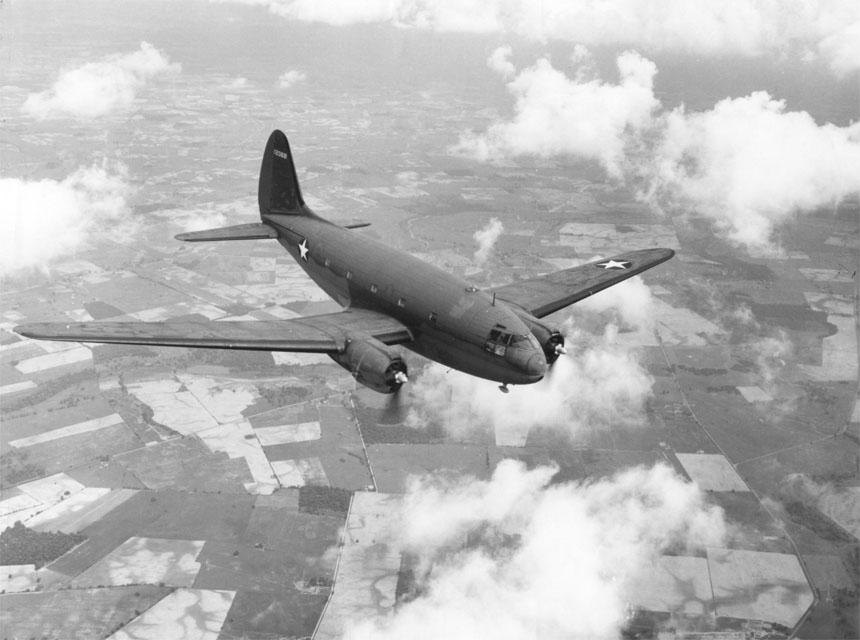
Curtiss C-46 Commando. (US Air Force photo, public domain)

A Waco CG-4A glider. (US Army Air Force, public domain)
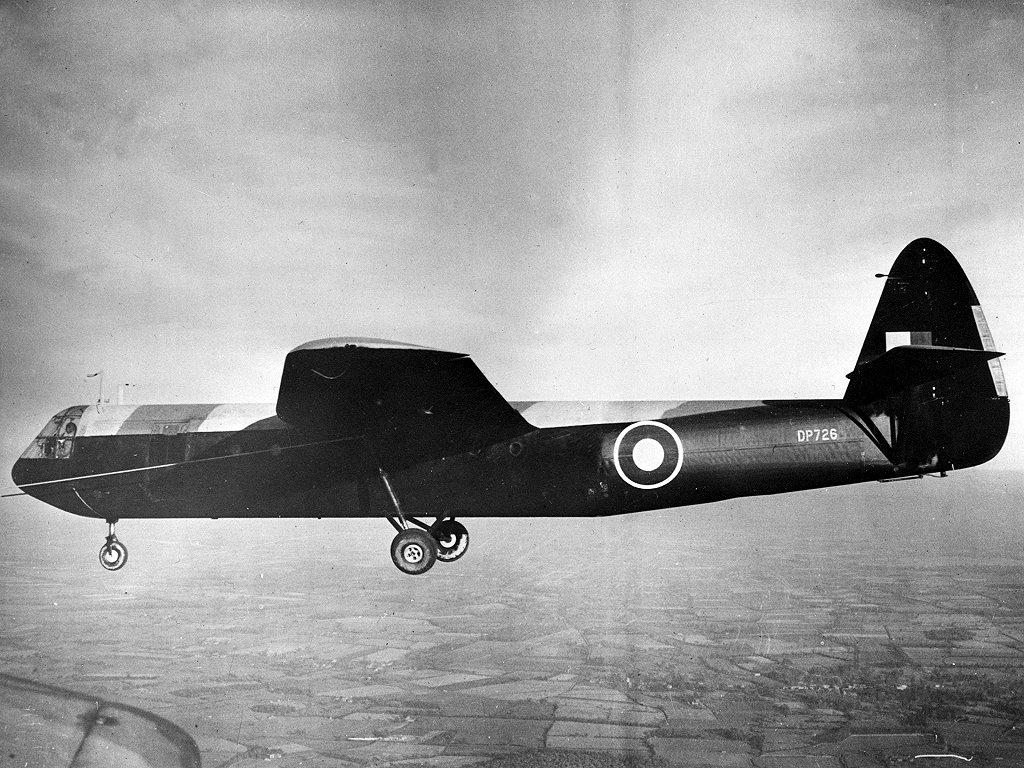
A British-built Airspeed Horsa glider on tow. (Public domain)
A 'flaming torch' Pathfinder badge awarded to Pathfinder students - both aircrew and paratroopers – upon successful completion of the Pathfinder training course. It was worn on the lower left arm. This original badge was worn by Private William Wheeler, a pathfinder in the 101st Airborne Division. (Richardelainechambers (talk) (Uploads), Public domain, via Wikimedia Commons
IX Troop Carrier Command Pathfinder School
In addition to the above units, IX TCC established its own Pathfinder School at Cottesmore airfield on 28 February 1944; it moved to RAF North Witham, Lincolnshire, on 22 March 1944 because of overcrowding at Cottesmore.
Suitable aircrew candidates for Pathfinder training were selected from all three Troop Carrier Wings and trainee Pathfinder paratroopers were drawn from the US 82nd and 101st Airborne Divisions.
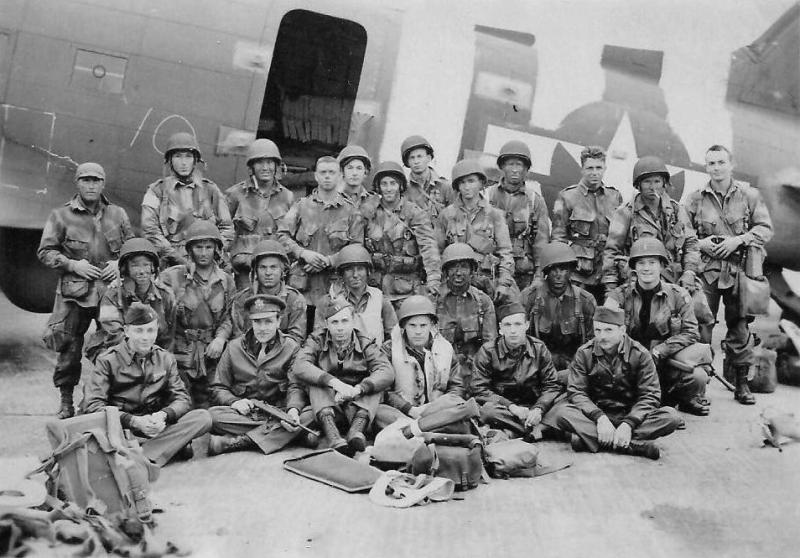
North Witham, 5 June 1944: Pathfinders of the 2nd Battalion, 505th Parachute Infantry Regiment, 82nd Airborne Division, and aircrew of the C-47 that would fly them to Normandy just hours later. (US Army photo, public domain)
Pathfinders from North Witham led the US parachute and glider assault on Normandy on 6 June 1944 (D-Day) and a detachment of 12 Pathfinder aircraft were sent to Italy to lead the Allied airborne landings of Operation DRAGOON on 15 August 1944. The Pathfinders moved from North Witham to Chalgrove in Oxfordshire on 14 September 1944, just three days before they led US Airborne landings in the Netherlands during Operation MARKET GARDEN.
GROUND COMPONENT
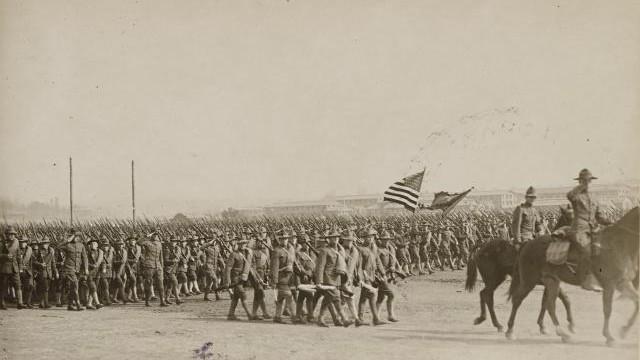
GROUND COMPONENT
US 82nd Airborne Division
The 82nd Division was formed in August 1917 as a standard infantry division following the United States’ entry into World War I.
The Division’s personnel were very diverse, including many immigrants who spoke little or no English. Uniquely for the time, its men were drawn from all 48 states, and it was nicknamed ‘All American’ as a result. This name is represented by the ‘AA’ letters on its Divisional badge.
The Division fought in France during the war and demobilized in May 1919 in New York. Two members of the Division won Medals of Honor for their bravery in action: LTC Emory J Pike and Corporal Alvin C York. In 1921, the Division was reconstituted in the Reserves.
The Japanese attack on Pearl Harbor in December 1941 led to the Division being ordered into active service in March 1942 at Camp Claiborne, Louisiana.
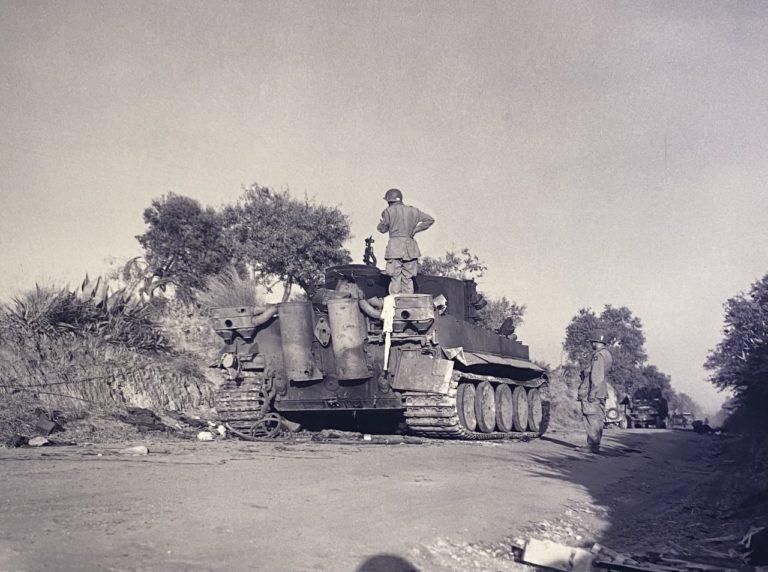
82nd Airborne paratroopers inspect a Tiger tank of the Hermann Goering Panzer Division near Gela, Sicily. The tank was knocked out by men of the Division’s 505th Parachute Infantry Regiment. (US Army)
In August 1942, the Division was reorganized and designated the 82nd Airborne Division. It was shipped to North Africa in May 1943 and then took part in the combined British and American airborne assault on Sicily during Operation HUSKY in July 1943. In September 1943, the Division’s 504th Parachute Infantry Regiment dropped into the Allied beachhead at Salerno to help strengthen it against German attacks, and then the 504th carried out a successful seaborne assault nearby.
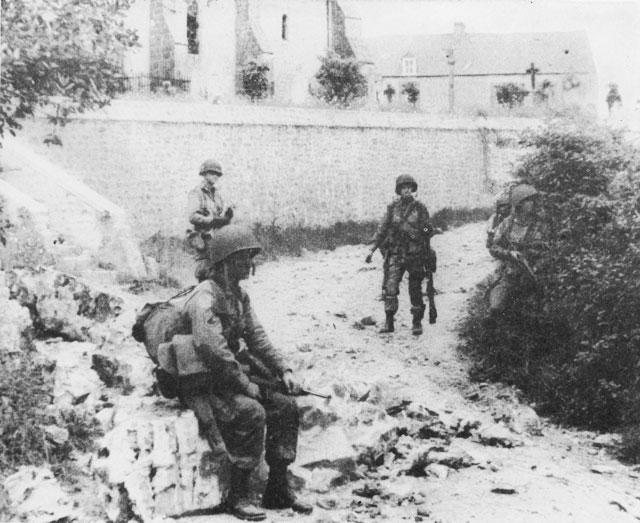
Paratroopers of the 82nd Airborne Division pause for a rest near the church in St Marcouf, 6 June 1944. (US Army photo, public domain)
In December 1943, the 82nd Airborne Division shipped to Northern Ireland in preparation for the Allied assault on Normandy, leaving the 504th on operations in Italy. In February 1944, the 82nd transferred to the East Midlands region of England. Units of the 82nd Airborne Division were primarily based in Leicestershire and Nottinghamshire but many of its units flew into combat from airfields in South Kesteven.
For Operation NEPTUNE (D-Day, 6 June 1944) around 12,000 paratroopers and glider troops of the 82nd landed in Normandy as part of the Allied invasion forces. Brigadier-General Gavin, Assistant Division Commander, 82nd Airborne Division, flew from Saltby airfield and jumped into Normandy on D-Day. Gavin was an expert in Airborne tactics, having written the US Army’s first manual on the subject, FM 31-30, Tactics and Technique of Airborne Troops.
The mission of the 82nd Airborne Division was to destroy bridges to deny mobility to German reinforcements and to capture causeways leading inland across the flooded areas behind the Normandy beaches so that Allied seaborne forces could rapidly move inland. The 82nd carried out its mission successfully and fought for 33 days without relief or replacements before returning to England.
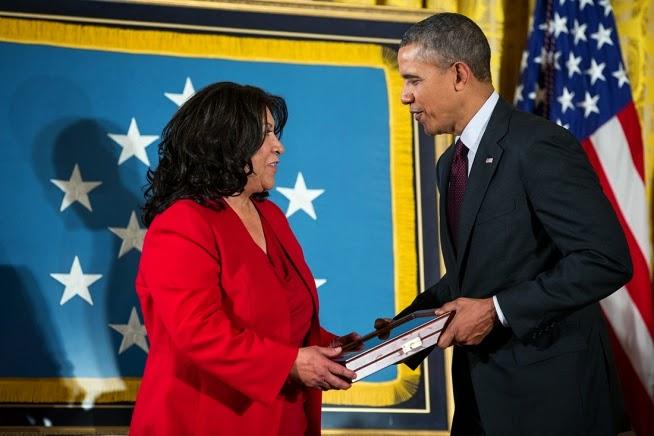
President Barack Obama presents the posthumous Medal of Honor for Private Joe Gandara to his niece, Miriam Adams, during the Medal of Honor ceremony in the East Room of the White House on 18 March 2014. (Official White House photo by Amanda Lucidon)
Private Joe Gandara (D Company, 2nd Battalion, 507th PIR) flew into Normandy from Barkston Heath airfield. He was killed while attacking enemy machine-gun positions and was posthumously awarded a Distinguished Service Cross for his bravery; this was upgraded to a Medal of Honor in 2014. 1
- 1
Private Gandara was a Latin American and the upgrade followed a review of veteran records to ensure those deserving the Medal of Honor were not denied because of ethnic prejudice. See ‘Valor 24’ in Medal of Honor: History and Issues, Congressional Research Service, Updated August 18, 2015, p16.
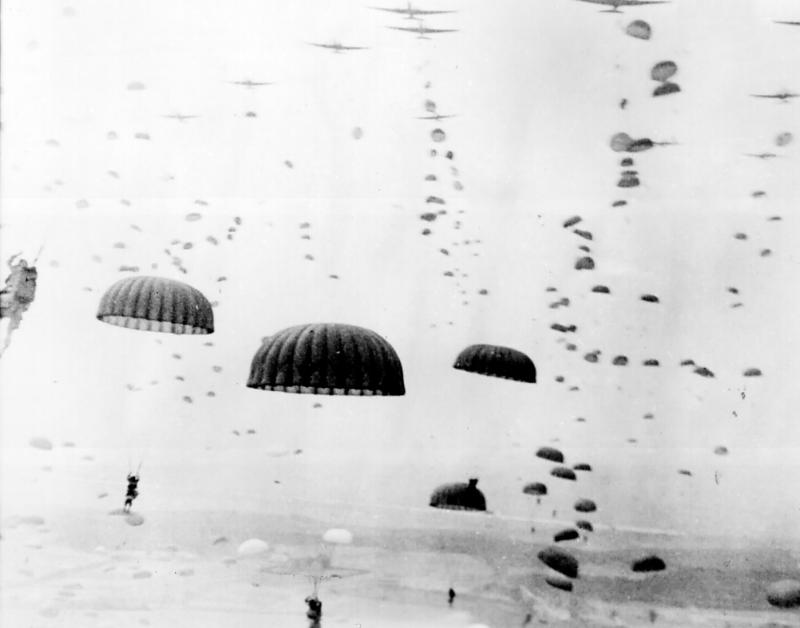
Paratroopers of the 82nd Airborne Division descending near Groesbeek on 17 September 1944. (US Army, via Wikimedia Commons)
In September 1944, the 82nd Airborne Division carried out its final airborne assault of the war when it was flown from airfields in the East Midlands to land near Nijmegen in the Netherlands, as part of Operation MARKET GARDEN. The Division’s mission was to capture and hold a number of bridges at Grave and Nijmegen so that British ground forces could pass northwards to Arnhem.
The 82nd captured the bridges at Grave and worked with British ground units to capture the huge road bridge at Nijmegen. During this action, 200 men of the 82nd carried out a very successful assault crossing of the river in daylight using small boats.

Troops of the 325th Glider Infantry moving through fog in the Ardennes during the ‘Battle of the Bulge’. (US Army Center for Military History, public domain, via Wikimedia Commons)
Until 10 November 1944, when they were relieved by Canadian forces, the 82nd patrolled the area around Nijmegen to help secure it. After 50 days of combat in and around Nijmegen, the Division was then sent to France to recuperate and await further action.
In December 1944, German forces made a surprise counter-attack into the Ardennes - which developed into the ‘Battle of the Bulge’ - and it sent the defending US forces reeling for a while.
The men of the 82nd were rushed into combat with little food, ammunition, and winter clothing. They endured the German attacks until they eventually took the offensive themselves, and by February 1945, the Division was pushing into Germany.
During the final months of the war, the Division liberated a forced-labour camp and accepted the unconditional surrender of 146,000 men of the German 21st Army.
BIBLIOGRAPHY
Bailey, Roderick, Forgotten Voices of D-Day, Paperback edition (London, 2010)
Barrymore Halpenny, Bruce, Action Stations 2: Military Airfields of Lincolnshire and the East Midlands (Wellingborough, 1981)
Beevor, Antony, D-Day - the Battle for Normandy, Kindle version (London, 2019)
Berry, Adam G R, And Suddenly They Were Gone (Boston, UK, 2015)
Berry, Adam G R, and Hans Den Brok, A Breathtaking Spectacle (Boston, UK, 2019)
Chant, Chris, Airborne Operations, ed. by Philip de Ste Croix, Paperback (London, 1982)
Congressional Research Service, ‘Medal of Honor: History and Issues’, Congressional Research Service (2015) <https://crsreports.congress.gov/product/pdf/RL/95-519/15> [accessed 2024]
Crookenden, Napier, ‘6th Airborne Division’, The D-Day Encyclopedia (Oxford, 1994), 519–21
Dear, Ian, and M R D Foot, The Oxford Companion to the Second World War (Oxford, 1995)
Delve, Ken, Military Airfields of Britain (Ramsbury, 2008)
Ford, Ken, Steve Zaloga, and Stephen Badsey, Overlord : The D-Day Landings (Oxford, 2009)
Freeman, Roger A, UK Airfields of the Ninth Then and Now (1994)
Gregory, Barry, and John Batchelor, Airborne Warfare 1918-1945 (London, 1979)
Hamlin, John F, Support and Strike! A Concise History of the US Ninth Air Force in Europe (Peterborough, 1991)
Harrison, Gordon, Official History of the US Army in World War II : The European Theater of Operations : Cross-Channel Attack, Pickle Partners Publishing e-book edition (2013)
Hastings, Max, Overlord : D-Day and the Battle for Normandy 1944, Hardback (London, 1989)
Holmes, Richard, The Story of D-Day, 6 June 1944 (London, 2004)
Kershaw, Robert J, It Never Snows in September (New York, 1999)
Koskimaki, George, D-Day with the Screaming Eagles, Mass Market Edition (New York, 2006)
———, Hell’s Highway (Havertown, 2003)
Laurenceau, Marc, ‘D-Day American Airborne Operations’, D-Day Overlord, 2016 <https://www.dday-overlord.com/en/d-day/air-operations/usa>
Man, John, The Atlas of D-Day1994 (London, 1994)
Margry, Karel, Market Garden Then and Now Boxed Set (2002)
Marix Evans, Martin , and William Jordan, D-Day and the Battle of Normandy (Andover, 2004)
Marix Evans, Martin, Wybo Boersma, and Adrian Groeneweg, The Battle of Arnhem (Andover, 1998)
Mcmanus, John C, September Hope : The American Side of a Bridge Too Far (New York, 2013)
Moran, Jeff, American Airborne Pathfinders in World War II (Atglen, PA, 2004)
Mrozek, Steven J, ‘82d Airborne Division’, The D-Day Encyclopedia (Oxford, 1994), 205
Nordyke, Phil, All American, All the Way : The Combat History of the 82nd Airborne Division in World War II (St. Paul, Mn, 2005)
Otway, Terence B H , Airborne Forces of the Second World War, 1939-45, Facsimile of War Office publication of 1951 (Uckfield, 2019)
Preisler, Jerome, First to Jump (New York, 2014)
Ramsey, Winston, D-Day Volume 1 (1995)
———, D-Day Volume 2 (1995)
Rapport, Leonard, and Arthur Northwood, Rendezvous with Destiny : A History of the 101st Airborne Division, Kindle edition (2015)
Ruppenthal, Roland G, United States Army in World War II - UTAH Beach to Cherbourg - 6-27 June 1944 [Illustrated Edition] (2014)
Ryan, Cornelius, A Bridge Too Far, 3rd edn (London, 1978)
Salamander Books Ltd, D-Day, Operation Overlord (London, 1993)
Saunders, Tim, The Island - Nijmegen to Arnhem (Barnsley, 2008)
Siddall, Brian, ‘Airborne in Normandy’, Airborneinnormandy.com (2006) <https://www.airborneinnormandy.com/> [accessed 2022]
Sowrey, Frederick, ‘Pathfinders’, The D-Day Encyclopedia (Oxford, 1994), 416
US Army, ‘82nd Airborne Division - D-Day - Normandy - after Action Report’, D-Day Overlord (2016) <https://www.dday-overlord.com/en/battle-of-normandy/after-action-reports/82nd-airborne/d-day> [accessed 8 December 2024]
Vlahos, Mark C, Men Will Come, Second Edition (Hoosick Falls, NY, 2021)
Warren, John, Airborne Operations in World War II, European Theater, Defense Technical Information Center (1956) <https://apps.dtic.mil/sti/tr/pdf/ADA438105.pdf> [accessed 8 December 2024]
Weeks, John, Airborne Equipment (Newton Abbot, 1976)
———, Assault from the Sky (Newton Abbot, 1988)
Wikipedia Contributors, ‘American Airborne Landings in Normandy’, Wikipedia (2020) https://en.wikipedia.org/wiki/American_airborne_landings_in_Normandy> [accessed 2024]
Zaloga, Steven J, US Airborne Divisions in the ETO 1944–45 (Oxford, 2007)
